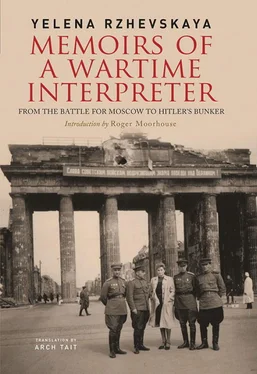We were searching: in the complex, in the garden, in the building above ground, and in nearby stretches of the street. On the morning of 4 May, I had a quiet, domesticated and completely civilian man sitting in front of me, a little stoker nobody in the Reich Chancellery had noticed. As a technician, he had been sent to the Führer’s bunker to mend the malfunctioning ventilator.
He had already told us that, while he was in the corridor, he had seen the bodies of the Führer and Eva Braun being taken out of Hitler’s rooms, wrapped in grey blankets. She was wearing a black dress. He was not trying to persuade us of anything, just telling what he had seen. In a chorus of louder, more assertive voices the ring of truth was somehow missing. The stoker himself was so unassuming, so humble, that it was difficult to believe he could have any role to play in events of this magnitude. Vice Admiral Voss seemed far better suited to the role, only he had no direct evidence to give.
The stoker was the first German from whom I heard about Hitler’s wedding. At the time, in a Berlin where the fighting and the fires had barely died down, it struck me as ridiculous beyond belief. I looked again at the humble, ordinary man who was matter-of-factly thinking through the bizarre scenes he had witnessed in the last three or four days, as if they were something from an infinitely remote past. The truth was that we had moved not just from one day to the next, but out of one epoch and into another.
I have forgotten the stoker’s name. He juts out of the tome of history, an anonymous bookmark pointing us to the right page. Incredulous, inattentive, we had not taken the time to read it carefully.
Helmut Kunz, the doctor of the medical department of the SS in Berlin, was feverishly agitated. He could not get over what he had experienced. He had ended up in the Reich Chancellery almost by accident and was traumatized by his complicity in the murdering of children. The first day, everything he said revolved only around that fact. On 4 May, however, he sighed, gave a start and, mixing up the dates, began chaotically recalling the details of the last few days.
He confirmed that Hitler and Eva Braun had married by remembering he had been present when Braun told Professor Haase, the director of the Chancellery hospital, that Goebbels’ children addressed her that day, as they always did, as ‘Tante Braun’, Auntie Braun, and she had corrected them to ‘Auntie Hitler’.
Then he remembered he had been sitting in the evening in the casino above the Führer’s bunker in the company of Professor Haase, Frau Junge and Frau Christian, two of Hitler’s secretaries. Eva Braun had come in and the four of them went to one of the rooms in the casino where they were served coffee. Eva told them the Führer had written a will, which had been sent out of Berlin, that he was waiting for confirmation that it had been delivered to its destination, and only then would he die. She said, ‘Everybody has betrayed us, even Göring and Himmler.’ She added, ‘Dying will not be so difficult, because we have already tested the poison on the dog.’ Dr Kunz was adamant that this conversation in the casino had taken place on the evening of 30 April, whereas, according to other sources, Hitler was already dead by then.
We were encountering conflicting accounts every step of the way, but there was one almost casual remark Kunz made that we could not ignore. He said that Goebbels’ wife, telling him about Hitler’s suicide, did not add anything definite about how he had done it but, ‘There were rumours,’ Dr Kunz told us, ‘that his body was to be cremated in the garden of the Reich Chancellery.’
‘Who exactly did you hear that from?’ Colonel Gorbushin asked. ‘I heard it from Rattenhuber, the SS Obergruppenführer responsible for security at the Führer’s headquarters. He said, “The Führer has left us alone, and now we have to drag his body upstairs.”’
On that day, 4 May, we had no more authoritative testimony than this information from the head of Hitler’s bodyguard, communicated to us by Dr Kunz.
Documents Found Inside and Outside the Führerbunker
I am snowed under with documents. There are reports from locations where there is fighting, orders issued by the command post of Mohnke’s brigade, which was defending the Reich Chancellery, radio-telegrams.
In Goebbels’ rooms we find in two suitcases, besides his diaries, several screenplays sent to him by their authors; and a huge album, an anniversary gift from Nazi Party comrades for his fortieth birthday. It contains sheets of photographs, reproducing page after page of Goebbels’ manuscript The Little ABC of the National Socialist.
It was difficult to work in the underground complex itself, where the electricity supply failed periodically, and I spent many hours analysing documents in one of the halls of the Reich Chancellery. It was the reception hall where people waited for Hitler to appear, I think, or some other. I am not sure exactly. (I had trouble working out the layout of the Reich Chancellery.) Everything seemed to have been overturned. Perhaps this was where the SS security guards had made their last stand; also, the army had passed this way, and had no reason to respect the furnishings in the grand rooms of the headquarters of Nazism.
Tables had been knocked over, glass lampshades smashed, chairs had been overturned and their seats ripped open. Everywhere were shards of glass from the windows. I still remember the special floor of this room, entirely covered by a velvety grey velour, now trampled and torn by Red Army boots. The reconnaissance squads were bringing in sackfuls of documents and dumping them on that special flooring.
In Goebbels’ rooms we also found several files in a suitcase that contained Magda Goebbels’ personal papers. What did she bring with her when she moved to the underground complex on 22 April from her house on Göringstrasse? There were inventories of the furnishings in the country house in Lanke, and in the castle in Schwanenwerder, which had been built by the time of the war with the Soviet Union. Everything was listed: fittings, cabinets with silver, dinner services and figurines. Nothing was overlooked: every ashtray, every cushion in the innumerable rooms, every last handkerchief of Dr Goebbels and its place in the linen cupboard, every toilet paper holder. And so from one room to the next, in the main building and the outbuildings: bedrooms, offices, children’s and adjutants’ bedrooms, guest rooms, halls, vestibules, stairs, corridors, terraces, servants’ rooms, and cinemas. An inventory of Goebbels’ wardrobe. Eightyseven bottles of assorted wines.
There were bills detailing the cost of furnishing the castle, about which Goebbels writes enthusiastically in his diary, and sundry department store bills going back as far as 1939 and addressed to Magda Goebbels. Inventories of the children’s clothing, individually for each one of them. All their dresses, coats, hats, shoes, ski suits and underwear are listed. Items that are new, and items handed down from the eldest daughter to the second in seniority, from the second to the third, and so on. And items that, for the present, were being held in reserve. A certificate awarded to her as a participant in the Olympic Games, signed by the Führer.
There was also a paper, sent to Magda Goebbels, stamped with the seal of the National Socialist German Workers’ Party and signed by one of the Party leaders of the Berlin district. It contained the forecasts of a fortuneteller. He predicted in April 1942 there would be a parachute landing of Allied forces on the coast of France in early June 1942 and that fierce battles would follow. These would be at their fiercest in August 1944. In mid-June of that year, the prophecy continued, the Germans would use a new aerial weapon which would cause untold destruction, especially in England. This would lead to domestic political difficulties in Britain that would hamper the further advance of the Allies.
Читать дальше











